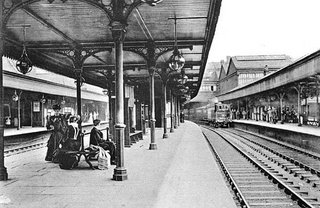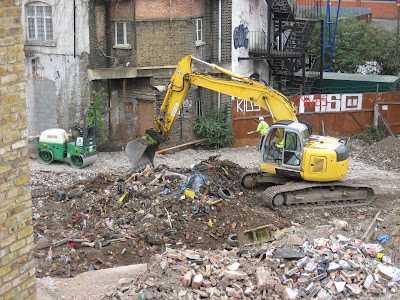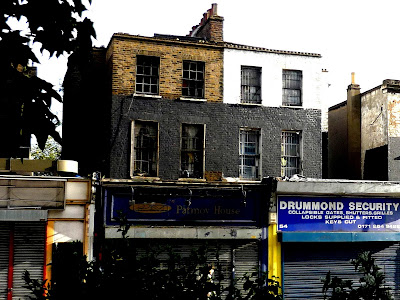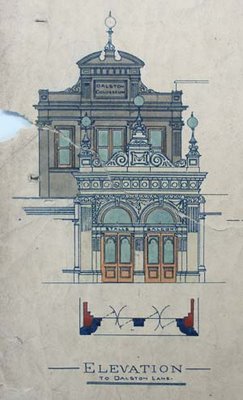An auction of Dalston's £63million bus stop, which has been built on The Slab over Dalston Junction station, took place at an OPEN public event on 16.9.10. The event was packed with Dalston residents for an evening which included literature, poetry, music, local news and satire. The politico-cultural soiree was delivered, almost without exception, by performers from our local creative community who live within walking distance of the venue.
If you missed the OPEN event at St Barnabas Church then here is your chance to listen to podcasts of what took place ( go to the OPEN podcast site here).
David Garrard of English Heritage told us how the Grade II* listed St Barnabas church ("the building I should like to be remembered by") was designed by the architect, Charles Herbert Reilly. And how the pre-modernist 1911 brick and concrete Byzantine basilica had been softened by a core of vivid colour and decoration, much of it provided by the Liverpool sculptor Tyson Smith.
On the night of the event the church had been lit to stunning effect using Arcola's carbon free hydrogen lighting, which created an atmosphere of intimacy and enchantment..jpg) Event lighting and photos courtesy of Arcola's David Salter.
Event lighting and photos courtesy of Arcola's David Salter.
Also from Arcola Theatre its producer and playwright Leyla Nazli, and Arcola Energy's Dr Ben Todd, told us of the 10 year history of building Arcola's national reputation in Dalston and its public appeal for £150K to help their current move to the Colourworks in Ashwin Street, Dalston. A recent street party in Ashwin Street in front of the Reeves Printhouse and Colourworks
A recent street party in Ashwin Street in front of the Reeves Printhouse and Colourworks
Antony Gormley, who has donated an artwork for auction, and designer Katharine Hamnett have joined forces with the Arcola Theatre to support its ambitious fund-raising efforts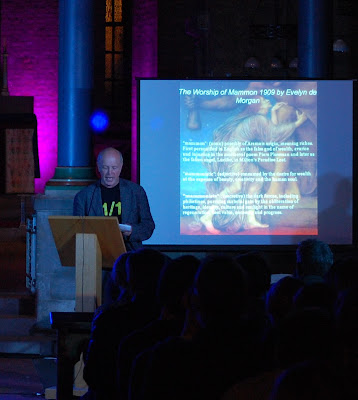
 The Worship of Mammon by Evelyn de Morgan, 1909. From super-hero to sub-zero, 2009
The Worship of Mammon by Evelyn de Morgan, 1909. From super-hero to sub-zero, 2009
During the evening we had two sets of music from local musicians The Dulce Tones. They were also joined by the next generation, two local youngsters, for a rendition of The Pink Panther.
Then there was the presentation of the Ceausescue Golden Spoon Award to Mayors Jules Pipe and Boris Johnson (regretably in their absence) by Steve Butters of Capacities Ltd. Winning the most public votes for the least popular development, the Golden Spoon award recognises the overbearing presence of the authorities' bulldozed scheme, Dalston Square. Lord Low of Dalston, OPEN's Patron and local resident, also spoke briefly on behalf of OPEN Dalston members who were presented with a certificate in tribute to their inspirational campaign and vigorous opposition to historic Dalston's obliteration and aspects of its redevelopment (hear their speeches on the OPEN podcast here).
Another highlight of the event was Michael Rosen, broadcaster, poet and former national Children's Laureate, who performed "Regeneration Blues" accompanied by improvised music from The Dulce Tones. You can hear the performance on the OPEN podcast here. It will be broadcast by the BBC later this month. Look out for more poetry and jazz events in Dalston in the future.
But there was little enthusiasm for the project amongst the auction bidders. The bus-stop was snapped up, for just £7.50, by a Clapton resident who happened to be walking home past the auction venue in Dalston. He heard the auctioneer, Michael Rosen, describe how the 488 route is to be extended from Clapton to Dalston Junction. The 488 is the only bus which will use the new £63million Transport Interchange which has been built on The Slab above the station.
"It'll be really handy for getting the train to Croydon" said the purchaser from Clapton, who preferred to remain anonymous, "but I do agree that a £63million Transport Interchange seems a lot for the public to pay just for my convenience".
(£7.50. It' s a start! Only another £62,999,992.50 to go to pay for The Slab. Ed)








